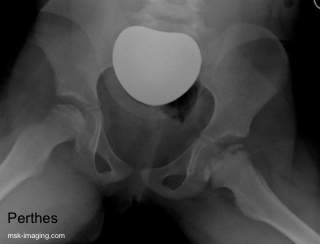Transient synovitis of the hip causes a self limiting painful hip disorder.
Boys are more commonly affected than girls
average age at onset is approximately 6 years.
The aetiology is unknown, some may have a traumatic cause
others may follow a viral infection.
Clinically, pain is present with limitation of movement and difficulty in walking.
Can be difficult to differentiate it from septic arthritis.
Although septic arthritis is rare, the consequence of under treating are catastrophic.
Untreated septic arthritis can cause marked articular cartilage destruction
If osteomyelitis is superimposed, early growth plate fusion can lead to deformity
Other causes of hip pain that need to be considered are:
• Perthe’s disease
• Slipped upper femoral epiphysis
• Intra-articular osteoid osteoma
• Childhood synovitides
A childhood osteonecrosis most frequently presenting in the first decade.
The cause of the condition is unknown.
The pattern is similar to avascular necrosis though there is a greater tendency for healing in the childhood variant.
The disease goes to a series of phases.
• Bony edema and a subchondral fracture.
• Sclerosis within the epiphysis progresses to
• Fragmentation phase
• which may then be followed by repair.
With mild disease, the anterior aspect of the femoral head is involved, similar to adults type AVN
Catterall phase 1 The contour of the femoral head is preserved
Catterall grade 2 More extensive involvement of the epiphysis
Catterall grade 3 Collapse begins
The earliest phase of collapse may be seen centrally
The metaphysis involved later.
Head assumes a mushroom like configuration.
Reversibility is more common in grade 1 and 2 lesions
Commonly appreciated on plain films although
There is a role for ultrasound and MR in the early detection
Bone scintigraphy has been used.
With modern imaging techniques, this high-dose radiation technology is less often used.
In patients suspected of Perthes disease, a frog lateral view should be obtained as this provides the clearest depiction of the epiphysis free from overlapping acetabular bone. Careful scrutiny of the ossified femoral head is necessary to detect early subchondral lysis and fracture.
Poor prognostic signs include
• Identification of calcification that has been extruded latterly
• Lateral subluxation of the femoral head
• Gage's sign is described as an osteoporotic V-shaped in the lateral aspect of the epiphysis.
Plain film findings have also been classified according to the degree of loss of height in the lateral third of the epiphysis.
This is the Herring classification.
Hip pain presenting early in the second decade may be due to SUFE
. Patients present with hip pain often following minimal trauma.
Males are more commonly affected than females
Said to occur more frequently when the child is overweight.
In most instances a plain film diagnosis is possible
Earlier subtle findings may be present on MRI
A number of plain film signs have been described.
• A line drawn along the lateral aspect of the femoral neck should intersect the epiphysis.
• loss of the normal overlap between the medial margin of the proximal femoral metaphysis and the posterior acetabular column
• Apparent loss of height of the epiphysis
• Abnormal Shenton’s line.
If slipped upper femoral epiphysis is considered on the frontal radiograph, it can usually be confirmed by the frog leg view
Many patients presenting with acute hip pain will also undergo an ultrasound examination.
This is because transient synovitis is a common cause of hip pain
Transient synovitis and Perthe’s disease tend to occur in a slightly younger age group. Between the ages of 6 and 10
The diagnosis should not be excluded on age criteria alone unless there is clear evidence of growth plate fusion. Ultrasound findings include
• joint effusion, which may be haemorrhagic,
• loss of alignment between the epiphysis and metaphysis across the growth plate.
• A step can occasionally be identified however remoulding can occur
• Reduced distance between the acetabular rim and the anterior margin of the metaphysis



